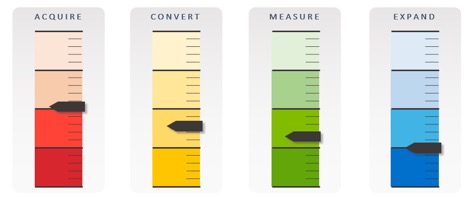
I’ve seen a lot of change during my many years in the marketing profession — and in demand generation in particular. The evolution of technology over those years has made it both easier (improved systems integration and automation capabilities) and more challenging (increasingly complex technology) for marketers to be at the top of their game.
With more channels, technologies, and tools than ever before (not to mention the changes in how people buy), it can be difficult to know where to put your focus. That’s where a marketing maturity model can be extremely helpful.
So, what is a marketing maturity model?
A marketing maturity model provides a solid foundation for implementing best practices, optimizing core processes, and measuring marketing’s impact on revenue.
At DemandGen, we created the Demand Factory , a marketing maturity model specifically designed for demand generation, which establishes a common vocabulary, best practices, and a framework for bringing together your initiatives in a synchronized way.
, a marketing maturity model specifically designed for demand generation, which establishes a common vocabulary, best practices, and a framework for bringing together your initiatives in a synchronized way.
The Demand Factory framework maps out everything marketers need to evaluate and optimize their demand generation efforts across four core areas:
- Acquire: The processes around generating new leads.
- Convert: The processes for turning leads into customers.
- Measure: Tracking and reporting campaign performance.
- Expand: Generating maximum value from your installed base.
In order to know where you can improve, you first need to assess your current marketing maturity across each of these areas.

With a focus on Acquire, Convert, Measure, and Expand, you can build a rock-solid
foundation for your marketing organization and improve marketing maturity.
Just as fine wine doesn’t mature in a single day, developing marketing maturity doesn’t happen overnight. It evolves over time, and requires communication, teamwork, and taking the time to define and map out your current processes.
Assess your current marketing maturity
Ready to improve marketing maturity in the specific discipline of demand generation? Start by evaluating your current capabilities within each of the following areas:
- Workflow Automation
Document workflows and processes and take advantage of your MarTech tools. Marketing Automation platforms and other MarTech tools have changed the game for marketing. Make sure you’re using them to their full advantage. By defining your project and campaign workflows, and mapping out each customer touchpoint, you can streamline campaign planning and execution and setup trigger-based marketing campaigns. Don’t forget about automating your internal workflows as well. Project management tools such as Jira, Workfront, and Trello have been specifically developed with built-in functionality to assign and track work.
Learn more: Build Engagement – and Relationships – with Trigger-Based Marketing
- Lead Management
Get the right leads to the right salespeople at the right time. Lead management is the backbone that supports all marketing and sales processes and activities. Without a lead management process in place, it’s difficult to determine where a particular lead might fall within the buyer’s journey. If you don’t know an individual’s level of interest, you will most likely send the wrong communication at the wrong time, and Sales will waste precious time reaching out to junk leads. Master the basics of lead management with a lead management framework.
Learn more: Back to Basics: Lead Management 101
- Lead Scoring and Nurturing
Qualify leads and keep them engaged. Lead nurturing and lead scoring strategies help build a more robust lead management framework. However, more than a third of sales and marketing professionals say integrated processes such as scoring and lead management are flawed or broken. It’s imperative to break down silos and develop a single source of data that both sales and marketing can agree on and use. By delivering personalized content and resources, lead nurturing tailors communication to the interests of potential buyers. According to Forrester Research, the best lead nurturing programs generate 50% more sales-ready leads at 33% lower cost. Lead scoring takes behavioral intent as well as many qualification factors into account and serves as a prioritization tool for Sales to determine who is most likely to make a purchase.
Learn more: 6 Things To Do NOW (to prepare for effective Lead Scoring in the future)
- Data Management
Continually enhance contact data and keep your database clean and up to date. Data has become so big, so complex, so spread across systems, and so vital to analyze — yet lack of accurate and shared data is the #1 challenge to sales and marketing alignment. Data isn’t just important for effective marketing. It enables effective marketing. Ensure your target market data is sufficiently defined, captured, and measured. Map out your ideal customer profile – those who are a great fit and have the highest potential customer lifetime value. Ready to clean up your data? Find out what to look for and learn how Data Operations is going to take center stage in marketing.
Learn more:
Forensic Data Analysis: Track Down the Bad Data Like a Crime Scene Detective
Marketing Now Needs a Data Operations Function
- Campaign Management
Define campaign workflows and create a consistent, repeatable process. Is every email campaign a new adventure? While you may thrive on juggling chaos, most people don’t. Establishing a campaign management framework creates a defined, repeatable process for your entire team to follow, which helps to keep your campaigns on brand, on time, and error-free. Once you’ve mastered the basics, you’ll have the time to measure and optimize campaign performance.
Learn more: Spring Cleaning for Your Campaign Execution
- Personalization
Send targeted campaigns. Customers expect personalized content in the digital age, and 74 percent get frustrated when they don’t get it. And it’s more than just addressing a contact by name; it’s ensuring relevance of content at the right stage of the customer journey. Whether you’re targeting customers and prospects by industry, buyer persona, revenue, or another category, segmentation plays an invaluable role — so make sure your data management practices can support it. Personalization tools are widely available nowadays, so it’s easier than ever to incorporate into your campaigns.
Learn more: When Looking to Improve Campaign Results, Look to Your Segmentation First
- Website/Form Conversion
Design landing pages that convert. Landing pages and forms are often the first point of contact with prospects. If you’re not careful they can also be the last, so make them count. It’s important to put some time into making a good first impression so that prospects actually complete your form, and you can make smart decisions based on the information they provide. From providing a consistent experience and progressive profiling to engaging prospects with the right content at the right time, the often-rushed landing page is crucial.
Learn more: Making a Good First Impression: 10 Tips for Landing Pages and Forms That Convert
- Testing Management
Make testing a priority and implement your findings. A/B testing used to strike fear in many a marketer’s heart. Today, though, marketing automation tools like Eloqua and Marketo make it simple to set up and conduct A/B tests. It’s a quick, low-risk way to find out which creative and messaging resonate better with your clients and prospects. You can test just about anything: subject line, personalization, layout, button color… you name it. And sometimes the simplest change can have the biggest results. Just be sure to review past performance, form a hypothesis, and act on the results.
Learn more: 3 Steps for Successful A/B Testing: Start Small and Just Do It
How did you do? While this isn’t a comprehensive list, it provides a good starting point by helping you understand where you already excel and where you need to improve.
By defining and implementing best practices, and then refining and optimizing core processes, you’ll see a positive impact on demand generation, conversions, and revenue attributed to marketing efforts.
DemandGen specializes in defining and optimizing demand generation processes for marketing organizations of all sizes. Download our Demand Factory eBook to learn how to get your organization’s Demand Factory up and running, and get in touch if you need help reaching marketing maturity!
 John Bokelmann leads the Managed Services team that supports DemandGen clients in digital marketing campaign development, production, and deployment. He provides strategic marketing operations leadership, develops and implements optimized workflow processes, and reinforces marketing best practices for both B2B and B2C clients.
John Bokelmann leads the Managed Services team that supports DemandGen clients in digital marketing campaign development, production, and deployment. He provides strategic marketing operations leadership, develops and implements optimized workflow processes, and reinforces marketing best practices for both B2B and B2C clients.
The post Achieve Demand Generation Success with a Modern Marketing Maturity Model appeared first on DemandGen.
About the Author
























